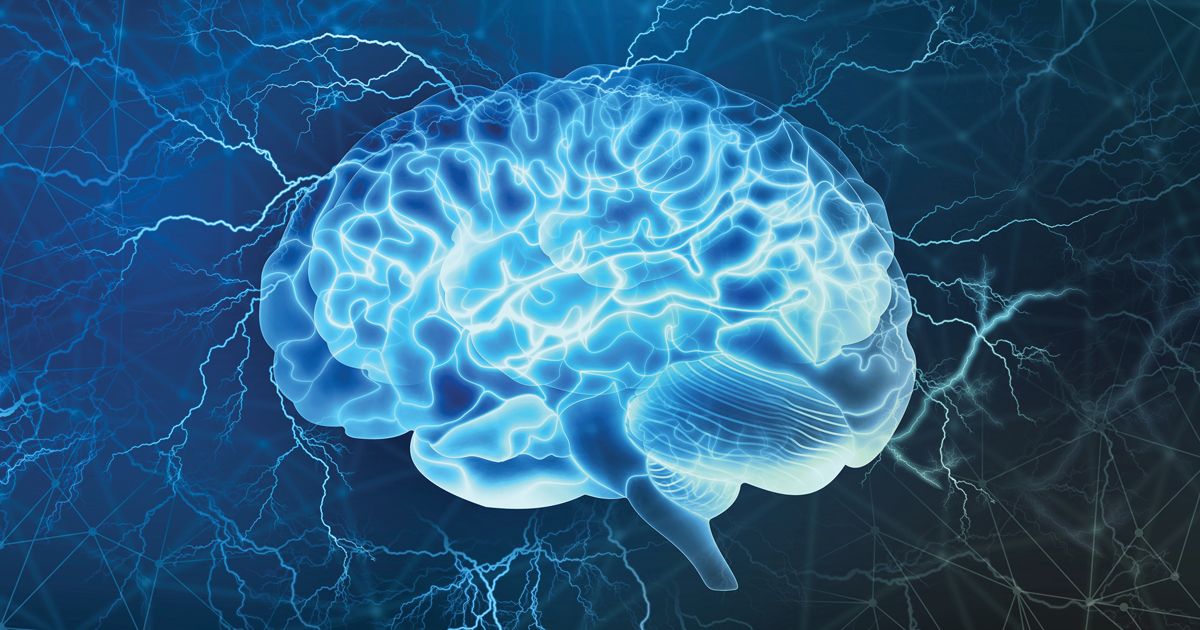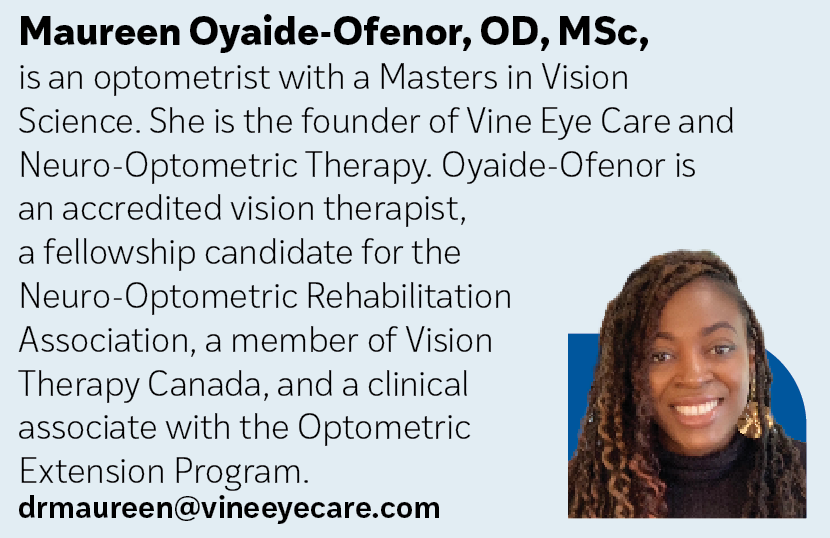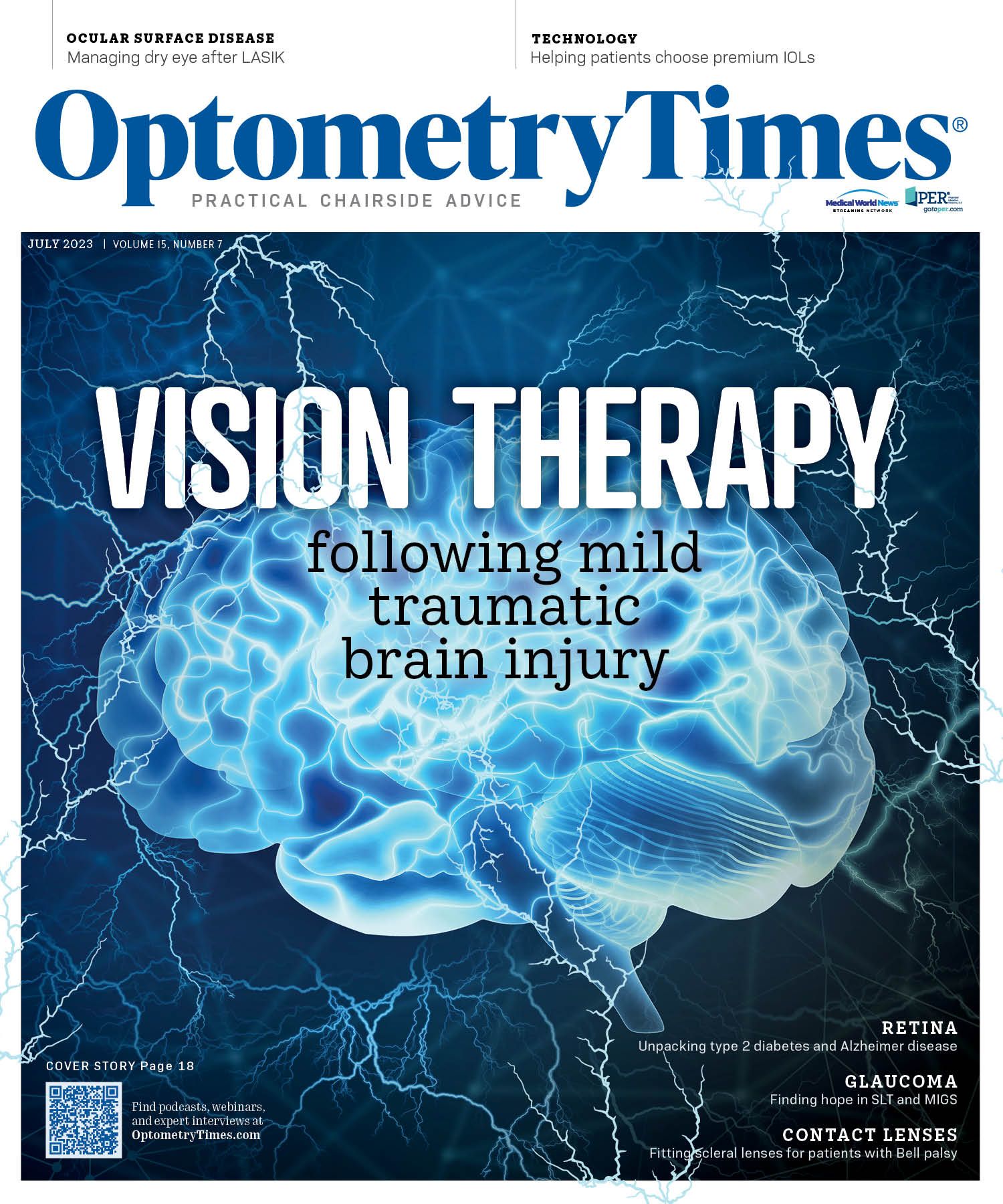How to improve visual function with vision therapy following mild traumatic brain injury
Successfully improving visual function in patients with MTBI requires an interdisciplinary approach and a collaborative effort between the patient and all involved allied health care providers.
Communication between the optometrist and allied health care providers is important. We are treating the body as a whole, and ignoring other parts to focus solely on visual function could delay improvement.10,13,15-19

There has been evidence of reduced visual functions in patients after mild traumatic brain injury (MTBI).1-5 Such visual functions include reduced near point of convergence, anomalies of accommodation, binocular vision dysfunction, photosensitivity, dry eyes, reduced functional and peripheral visual fields, dizziness, blurred vision, unilateral spatial inattention, abnormal egocentric localization, difficulty concentrating, reading problems, poor spatial or depth perception, interference with learning, starry-eyed appearance, low blink rate, and ambient visual system instability.1,3,4,6-8
Studies show that vision therapy can improve visual function after an MTBI.5,6,9-13 Following is some guidance for doing so. The aim is that optometrists and patients will be aware of what each party can do to improve visual function with vision therapy after an MTBI.
Neuro-optometric examination
Clinical findings and examination are needed for information on the visual status and cause of the MTBI. Begin with a thorough case history. Ask about work status; educational background; level of dependence or independence; referring professional and their area of specialization; reason for the referral; patient’s reason for the consultation; date of onset; presenting symptoms; level of pain and discomfort; history of medical and surgical treatments; list of medications; previous rehabilitation services received; summary of results from other disciplines; patient’s overall functional abilities, speech mobility, and alertness; and an overview of patient’s goal. Additional aspects of the clinical exam would include the following14:
» Unaided visual and dynamic visual acuity at far and near
» Subjective and objective refraction
» Eye and hand dominance
» Stereoacuity and color vision testing
» Functional and peripheral visual field test
» Binocular exam, extraocular motility testing, pursuit and saccades, amplitude of accommodation, near point of convergence, convergence and divergence ranges, vergence facility testing
» Pupil testing and measurements
» Intraocular pressure assessment
» Slit lamp exam, dilated fundus exam with the binocular indirect ophthalmoscope, macula and optic disc exam with the optical coherence tomography scan
» Test for abnormal egocentric localization
» Posture, balance, and gait assessment
» Line bisection or clock test for unilateral spatial inattention
» Effects of prisms, yoked prisms, tints, binasal conclusion on vision and gait
» Fill out brain injury vision symptom and convergence insufficiency symptom survey
» Visual ocular motor screening
» Visual motor sensitivity test
» Vestibular ocular reflex testing
» Development eye movement test
» Visual perception and information processing assessment
» Visual evoked potential
» Glare and photosensitivity testing
» Dry eye assessment
» Referral for MRI to rule out additional neurological causes
Collaboration with health care providers
Communication between the optometrist and allied health care providers is important. We are treating the body as a whole, and ignoring other parts to focus solely on visual function could delay improvement.10,13,15-19 Referral must be made to other allied health care providers when necessary.
The nonexhaustive list of allied health care providers includes the following: neurologists, rehab physicians, nurses, physical and occupational therapists, speech language pathologists,17 dietitians, neuropsychologists, audiologists, chiropractors, registered massage therapists, psychiatrists, psychologists, neuropsychologists, functional neurologists, neurosurgeons, physical medicine and rehabilitation, social workers, osteopaths, occupational and recreational therapists, orthotists, audiologists, and vocational counselors or therapists.
One of my patients was referred to me for vestibular ocular motility assessment and vision therapy by a neurologist. Once we started vision therapy, the neurologist recommended she see a massage therapist and not a chiropractor because her MRI scans indicated she had arthritis in the neck, and a study has shown massage therapy can help reduce pain and increase range of motion in patients with neck arthritis.20 While she progressed during vision therapy, the massage therapist was working on improving her range of motion. We waited for the massage therapist’s approval before we added head and neck rotations to improve her oculomotor visual function.
Once the corresponding health care provider has been involved in patient care, the optometrist must send reports and keep all providers updated on treatment plans. For patients with a history of depression, a reminder must be made to see a counselor, psychologist, or therapist. I always refer my patients with MTBI to the audiologist. Many of these patients have tinnitus and associated vestibular ocular postconcussion disorder.10,15,18
Vision therapy
Goals must be realistic, and expectations must be clear. It is important to have a plan, goals, and expectations on how long vision therapy will last. This must be written, as most of these patients have visual memory
or short-term memory loss.21 Therapy can last from 6 months to 2 years, and the duration depends on patients completing their home and in-office work.5,22,23 Patients are always made aware of the importance of keeping appointments.
In my practice, we provide a vision therapy kit and bag to store vision therapy equipment and binders. Patients must remember to bring their vision therapy bag and binder for each therapy session. The binder is always refilled with new activity for the week as well as steps on how to do this activity at home. During therapy sessions, emphasis is made on hydration and dry eye drops. After each activity, patients are asked to drink water, use their eye drops, and rate the severity of their headache, nausea, and dizziness. These ratings help me know when to switch or modify an activity.
Reminders and documentation
Most patients with brain injury have poor visual memory, so it is important to document every step of vision therapy. Sometimes videos are sent home so if patients forget how to do an activity, they can rewatch them. Each patient receives reminder calls and emails for the next vision therapy session. Most patients book a specific time and day for the session, which makes it easy to remember. A successful vision therapy for patients with brain injury involves a collaborative effort between the patient and allied health care professionals. Outlining the treatment plan and explaining the steps to achieving the goals can be done by the optometrist and vision therapist.
Nutrition and supplements
A protein-rich diet, omega-3 supplements, and vitamins C, D, and E are some dietary recommendations found to improve visual function in patients with mild brain injury.24-27 Patients are reminded to take the above vitamins and add omega-3 supplements. Referral can be made to the dietitian.
Conclusion

The neuroplasticity of the brain makes vision therapy a tool for improving visual function in patients with MTBI.28 Successfully improving visual function in patients with MTBI requires an interdisciplinary approach. This involves a collaborative effort between the patient and all allied health care providers involved.
Oyaide-Ofenor would like to thank Black EyeCare Perspective for the introduction to Optometry Times®. To learn more about Black EyeCare Perspective, please visit their website.
References
1. Kapoor N, Ciuffreda KJ. Vision disturbances following traumatic brain injury. Curr Treat Options Neurol. 2002;4(4):271-280. doi:10.1007/s11940-002-0027-z
2. Hac NEF, Gold DR. Neuro-visual and vestibular manifestations of concussion and mild TBI. Curr Neurol Neurosci Rep. 2022;22(3):219-228. doi:10.1007/s11910-022-01184-9
3. Santo AL, Race ML, Teel EF. Near point of convergence deficits and treatment following concussion: a systematic review. J Sport Rehabil. 2020;29(8):1179-1193. doi:10.1123/jsr.2019-0428
4. Barnett BP, Singman EL. Vision concerns after mild traumatic brain injury. Curr Treat Options Neurol. 2015;17(2):329. doi:10.1007/s11940-014-0329-y
5. Möller ML, Melkas S, Johansson J. Improving visual function after mild traumatic brain injury using a vision therapy program: case reports. Brain Sci. 2020;10(12):947. doi:10.3390/brainsci10120947
6. Barton JJS, Ranalli PJ. Vision therapy: ocular motor training in mild traumatic brain injury. Ann Neurol. 2020;88(3):453-461. doi:10.1002/ana.25820
7. Kwan SCK, Atiya A, Hussaindeen JR, Praveen S, Ambika S. Ocular features of patients with Parkinson’s disease examined at a neuro-optometry clinic in a tertiary eye care center. Indian J Ophthalmol. 2022;70(3):958-961. doi:10.4103/ijo.IJO_948_21
8. M.A. M. Hidden disability: Mild traumatic brain injury. Cephalalgia. 2017;37(1).
9. Tien S, Yit NC, Mazlan M. Neuro-optometric vision rehabilitation after pontine cavernoma: a case report. JUMMEC. 2021;24(2):15-20. doi:10.22452/jummec.vol24no2.3
10. Ziaks L, Giardina R, Kloos A. Integration of vision and vestibular therapy for vestibulo-ocular post-concussion disorder – a case study. Internet J Allied Health Sci Pract. 2019;17(3):11. doi:10.46743/1540-580X/2019.1754
11. Rasmussen RS, Schaarup AMH, Overgaard K. Therapist-assisted rehabilitation of visual function and hemianopia after brain injury: intervention study on the effect of the neuro vision technology rehabilitation program. JMIR Res Protoc. 2018;7(2):e65. doi:10.2196/resprot.8334
12. Smaakjær P, Wachner LG, Rasmussen RS. Vision therapy improves binocular visual dysfunction in patients with mild traumatic brain injury. Neurol Res. 2022;44(5):439-445. doi:10.1080/01616412.2021.2000825
13. Simkhovich D, Ciuffreda KJ, Tannen B. Successful oculomotor auditory feedback therapy in an exotrope with acquired brain injury. J Behav Optom. 2006;17(4).
14. Lazowski-Fraher D. Development of the neuro-optometric vestibular assessment or NOVA. Pain Res Manage. 2012;17.
15. Schlemmer E, Nicholson N. Vestibular rehabilitation effectiveness for adults with mild traumatic brain injury/concussion: a mini-systematic review. Am J Audiol. 2022;31(1):228-242. doi:10.1044/2021_AJA-21-00165
16. Warnecke J, Devine N, Olen C. Inpatient physical therapy rehabilitation provided for a patient with complete vision loss following a traumatic brain injury. Brain Inj. 2015;29(7-8):993-999. doi:10.3109/02699052.2015.1022877
17. Hardin KY, Kelly JP. The role of speech-language pathology in an interdisciplinary care model for persistent symptomatology of mild traumatic brain injury. Semin Speech Lang. 2019;40(1):65-78. doi:10.1055/s-0038-1676452
18. Wong CK, Ziaks L, Vargas S, DeMattos T, Brown C. Sequencing and integration of cervical manual therapy and vestibulo-oculomotor therapy for concussion symptoms: retrospective analysis. Int J Sports Phys Ther. 2021;16(1):12-20. doi:10.26603/001c.18825
19. Amorapanth PX, Kapoor N. Seeing the forest for the trees: the diagnosis and rehabilitation of functional visual impairment in a severely symptomatic patient with concussion. Vis Dev Rehabil. 2017;3(3):147-158. doi:10.31707/VDR2017.3.3.p147
20. Field T, Diego M, Gonzalez G, Funk CG. Neck arthritis pain is reduced and range of motion is increased by massage therapy. Complement Ther Clin Pract. 2014;20(4):219-223. doi:10.1016/j.ctcp.2014.09.001
21. Serra-Grabulosa JM, Junqué C, Verger K, Salgado-Pineda P, Mañeru C, Mercader JM. Cerebral correlates of declarative memory dysfunctions in early traumatic brain injury. J Neurol Neurosurg Psychiatry. 2005;76(1):129-131. doi:10.1136/jnnp.2004.027631
22. Sharieff K. From Braille to quilting: a neuro-optometric rehabilitation case report. Optom Vis Dev. 2010;41(2):81-91.
23. Conrad JS, Mitchell GL, Kulp MT. Vision therapy for binocular dysfunction post brain injury. Optom Vis Sci. 2017;94(1):101-107. doi:10.1097/OPX.0000000000000937
24. Scrimgeour AG, Condlin ML, Loban A, DeMar JC. Omega-3 fatty acids and vitamin D decrease plasma T-Tau, GFAP, and UCH-L1 in experimental traumatic brain injury. Front Nutr. 2021;8:685220. doi:10.3389/fnut.2021.685220
25. Khalili H, Abdollahifard S, Niakan A, Aryaie M. The effect of vitamins C and E on clinical outcomes of patients with severe traumatic brain injury: a propensity score matching study. Surg Neurol Int. 2022;13:548. doi:10.25259/SNI_932_2022
26. Lee JM, Jeong SW, Kim MY, Park JB, Kim MS. The effect of vitamin D supplementation in patients with acute traumatic brain injury. World Neurosurg. 2019;126:e1421-e1426. doi:10.1016/j.wneu.2019.02.244
27. Lust CAC, Mountjoy M, Robinson LE, Oliver JM, Ma DWL. Sports-related concussions and subconcussive impacts in athletes: incidence, diagnosis, and the emerging role of EPA and DHA. Appl Physiol Nutr Metab. 2020;45(8):886-892. doi:10.1139/apnm-2019-0555
28. Chang A, Cohen AH, Kapoor N. Top-down visual framework for optometric vision therapy for those with traumatic brain injury. Optom Vis Perform. 2013;1(2):48-53.

Newsletter
Want more insights like this? Subscribe to Optometry Times and get clinical pearls and practice tips delivered straight to your inbox.